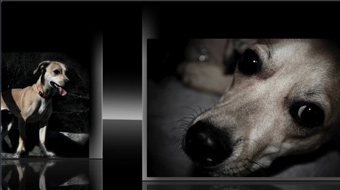This inexpensive and easy-to-use slide show generator is fast, but not terribly robust

The Pulse effect
Light slice uses some crazy, streaky transitions between images, and black reflection places your pics in a sliding tile that reflects in the floor below.

There’s a gallery on the Aquafadas Web site with video examples of all five generators.
The plug-ins are quite simple to use. You load the generator and edit the desired length into the timeline. The interface looks like this:

The main controls
The overall timing of the slides is controlled by Image Duration and Transition Duration sliders. You can customize background colors, change the size of the slides, choose which transitions you want to use and control how some of the slides move when in frame. You can also choose to display the name of the image file as well. The controls are quite simple, for the most part. As with most all FxFactory effects, parameters can be saved for later recall. Of course, there’s a free demo available so you can try it out for yourself.
While PulpFx Abstract works very well at what it does, the issue I have with it (and most of the canned slideshow generators in general) is that they often don’t seem very usable in real world post-production. There’s certainly the need to make use of still images on a pretty regular basis, but they are often best handled using pan-and-zoom techniques. For that the FxFactory freebie Pan and Zoom (Accelerated) is a much better option. Does it take longer to set up image moves with a dedicated pan-and-zoom tool than a canned slideshow plug-in? Absolutely. Are the two apps uses quite different? Very often they are.
Unfortunately, the five generators in PulpFx Abstract create results you might find in a PowerPoint presentation. That’s not something I want to do unless specifically asked by a client. The movements and transitions seem too flashy and scream “Hey, look at me! I’m a transition!”
To be fair, you can tone down a lot of what PulpFx Abstract has to offer. For example, with the Static Pulse generator you can turn off all of the transitions except for Crossfade and/or Fade In/Fade Out and get something that is a bit more simple and elegant. But there’s no option for a move on the stills, even a simple push in or out on the image. You could keyframe the height for each slide but that would be tedious and defeat the whole purpose of an automated solution.
What I would really love to see the PulpFx Abstract folks do (or any plug-in developer, for that matter) is to scale back the flying, flipping, rotating and flashing that these types of things often offer. I know, they are trying to appeal to a wider consumer/business audience. But they could find just as much success with far more simple and subtle options—gentle moves on the still images, dissolves or dips to black as a transition. This type of simple presentation should be easy to set up and would help the viewer concentrate more on the content of the photos and not the slideshow itself. In the case of automated slideshows from still images of your latest project, less is often more.











Leave a Reply